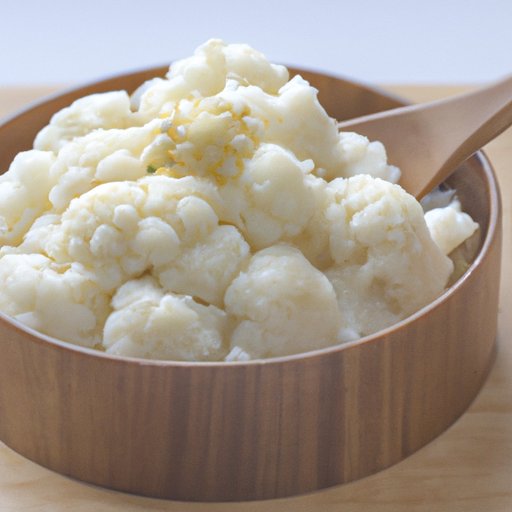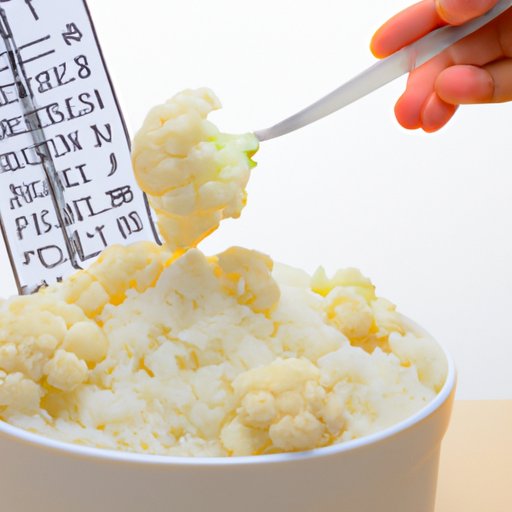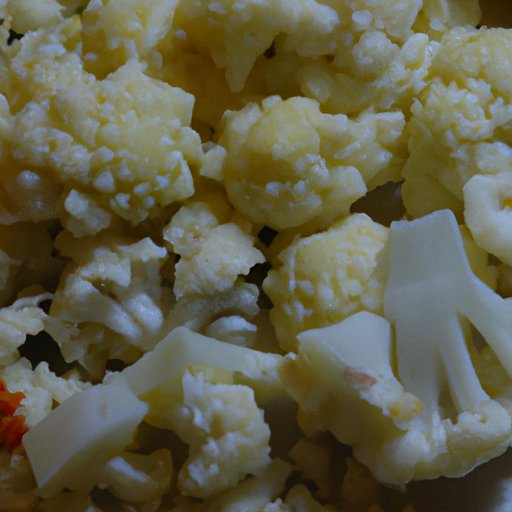Introduction
Cauliflower rice is a popular alternative to traditional white rice that has become increasingly common in recent years. It is made from raw or cooked cauliflower that has been chopped into small pieces and processed to resemble the texture of rice. Although it looks and tastes similar to white rice, it has significantly fewer carbohydrates, calories, and fat.
This article will explore the health benefits and potential risks of eating cauliflower rice. We will compare cauliflower rice to traditional white rice to evaluate their nutritional value, analyze its increasing popularity, and discuss ways to improve the taste and texture of cauliflower rice.
Exploring the Health Benefits of Cauliflower Rice
Cauliflower rice is a nutritious food that offers several health benefits. Let’s take a look at some of the most noteworthy advantages of this alternative to white rice.
Lower Calories than Traditional Rice
A cup of cooked white rice contains about 205 calories, while a cup of cooked cauliflower rice contains only 25 calories. This makes cauliflower rice an excellent choice for those looking to reduce their calorie intake without sacrificing flavor or texture. According to Dr. Michael Greger, MD, “If you’re trying to cut down on carbs and calories, cauliflower rice can be a great substitute for white rice.”
High in Fiber and Vitamins
Cauliflower is an excellent source of fiber and vitamins, including vitamin C, K, and B6. A cup of cooked cauliflower rice provides 3 grams of dietary fiber, which is important for gut health and regular bowel movements. The high levels of vitamins in cauliflower rice also make it beneficial for overall health and immunity.
Low Carbohydrate Content
Cauliflower rice is naturally low in carbohydrates, making it a great option for those following a low-carb diet. A cup of cooked cauliflower rice contains only 5 grams of carbohydrates, compared to 45 grams in a cup of cooked white rice. This makes it an ideal choice for those looking to reduce their carbohydrate intake.
Comparing Cauliflower Rice to Traditional Rice
Now that we’ve looked at the health benefits of cauliflower rice, let’s compare it to traditional white rice to get a better understanding of their nutritional value.
Nutritional Value Comparison
When comparing the nutritional value of cauliflower rice to white rice, it’s clear that cauliflower rice is the healthier option. Cauliflower rice is lower in calories, carbohydrates, and fat, and higher in fiber and vitamins than white rice. Additionally, it is gluten-free, making it a great choice for those with gluten sensitivities.
Taste and Texture Comparison
Although cauliflower rice looks and tastes similar to white rice, there are some differences in terms of taste and texture. Cauliflower rice tends to have a milder flavor and softer texture than white rice. Some people find the texture of cauliflower rice to be unappealing, but it can be improved with the addition of herbs, spices, and other flavorings.

Examining the Nutritional Content of Cauliflower Rice
Let’s now take a look at the macronutrients and micronutrients found in cauliflower rice.
Macronutrients
Cauliflower rice is low in calories, carbohydrates, and fat. A cup of cooked cauliflower rice contains only 25 calories, 5 grams of carbohydrates, and 0.4 grams of fat. This makes it an excellent choice for those looking to reduce their calorie and carbohydrate intake.
Micronutrients
Cauliflower rice is also high in several essential vitamins and minerals. It is an excellent source of vitamin C, vitamin K, and vitamin B6. It is also a good source of folate, potassium, magnesium, phosphorus, and iron. These vitamins and minerals are important for overall health and immunity.

Analyzing the Popularity of Cauliflower Rice
Cauliflower rice has become increasingly popular in recent years, due to its low-carbohydrate content and health benefits. Let’s take a look at why it has become so popular and where you can find it.
Reasons for Increasing Popularity
Cauliflower rice has become increasingly popular due to its low-carbohydrate content and health benefits. As more people become aware of the health benefits of cauliflower rice, its popularity continues to grow. Additionally, its mild flavor and soft texture make it a great alternative to traditional white rice.
Availability of Cauliflower Rice Products
Cauliflower rice is widely available in grocery stores, health food stores, and online. It can be purchased fresh or frozen, and many brands offer pre-made and ready-to-cook options. Additionally, many restaurants and meal delivery services now offer dishes featuring cauliflower rice.

Investigating the Potential Risks of Eating Cauliflower Rice
Although cauliflower rice is a nutritious and healthy food, there are some potential risks associated with eating it. Let’s take a look at two of the most common risks.
Allergies
Cauliflower rice may cause an allergic reaction in some people. Those who are allergic to cruciferous vegetables such as broccoli, cabbage, and kale may also be allergic to cauliflower rice. If you are allergic to any of these vegetables, it is best to avoid eating cauliflower rice.
Digestive Issues
Cauliflower rice may also cause digestive issues in some people. The high fiber content of cauliflower rice can cause gas, bloating, and abdominal pain. If you experience any of these symptoms after eating cauliflower rice, it is best to limit your intake or avoid it altogether.
Evaluating the Taste and Texture of Cauliflower Rice
The taste and texture of cauliflower rice can be off-putting for some people. However, there are some simple tricks you can use to make it more palatable.
Common Complaints
The most common complaints about cauliflower rice are that it tastes bland and has a mushy texture. Many people find the texture unappealing and the flavor lacking.
Tips for Improving Flavor and Texture
There are several ways to improve the flavor and texture of cauliflower rice. Adding herbs, spices, and other flavorings can help enhance the flavor. Additionally, cooking the cauliflower rice in a skillet or baking sheet can help to improve the texture.
Conclusion
In conclusion, cauliflower rice is a nutritious and healthy alternative to traditional white rice. It is lower in calories, carbohydrates, and fat and higher in fiber and vitamins than white rice. Additionally, it is naturally gluten-free and easy to find in grocery stores and online. However, it may cause allergies and digestive issues in some people and its taste and texture can be off-putting for some. With the right seasonings and cooking techniques, however, it can be a delicious and nutritious part of any meal.
Overall, cauliflower rice is a nutritious and healthy food that can provide numerous health benefits. While there are some potential risks associated with eating it, these risks can be minimized by limiting your intake and using proper cooking techniques. For those looking for a nutritious and delicious alternative to white rice, cauliflower rice may be the perfect choice.
(Note: Is this article not meeting your expectations? Do you have knowledge or insights to share? Unlock new opportunities and expand your reach by joining our authors team. Click Registration to join us and share your expertise with our readers.)
